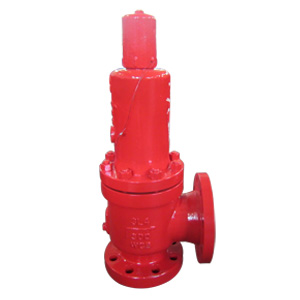Classification and structural characteristics of safety valves
Posted: 01/09/2019 16:19:53 Hits: 60
A safety valve is a valve type overpressure relief device, which is mainly comprised of three parts: the valve seat, disc, and loading mechanism. It is an automatic valve that uses the pressure of the medium itself to discharge a nominal amount of overpressure fluid through the opening of the valve disc to prevent the pressure within the device from exceeding the predetermined safe limit. When the pressure returns to normal, the disc automatically closes under the action of the loading mechanism to prevent the medium from continuing to drain.
The overall structure and loading mechanism can be divided into leverage type and spring type. A leverage type safety valve uses balance weight and leverage to balance the medium on the valve. (by changing the position of balance weight and leverage, or the weight to obtain a larger force or opening pressure) The load applied by this valve is not increased with the rise of the valve disc, and the valve is cumbersome due to its simple structure, so a leverage type safety valve is limited to low-pressure situations. The loading mechanism of the valve is sensitive to vibration and often leaks due to this. This valve is suitable for high-temperature applications, but the return pressure is generally lower than 70% of the working pressure to maintain the seal, so it is not suitable for continuous operation.
A spring-type safety valve uses the spring force to balance the force exerted by the medium on the valve disc. The opening pressure of the valve is adjusted by the screw and the compression of the spring. It has a compact structure and high sensitivity, a wide range of applications, but poor sensitivity to vibration. The installation location is not strictly limited. And it can also be used in mobile containers. The spring force changes with the opening of the valve disc, which is not conducive to the rapid opening of the valve disc. The long-term high temperature will affect the spring force. Therefore, the heat insulation or heat dissipation of the spring must be considered when using the container with higher temperature, which will lead to a complicated structure.
According to the ratio of valve opening height to flow diameter, safety valves can be divided into full-opening safety valve and micro-opening safety valve.
With a nozzle type valve seat, the momentum of the disc of the full-opening safety valve is given when the medium flow rate is increased. The recoil mechanism is used to change the flow direction of the medium, and the momentum is changed into a huge lift force so that the opening height of the valve disc can be increased. (The opening height is greater than or equal to 1/4 of the flow diameter.) This valve is suitable for applications where the discharge amount is large and the pressure fluctuation is small.
The opening height to flow diameter ratio of the micro-opening safety valve is 1/40-1/20. It is convenient to manufacture, repair and adjust, and should be used in situations where the amount of discharge is not large and the requirements are not high. Its diameter is much larger than the full-opening type with the same amount of discharge.
Safety valves can be divided into closed type and open type according to gas discharge. The valve cover of the closed type safety valve is closed, so the medium will not leak, and be discharged through the discharge pipe. It is mainly used for containers with toxic and flammable media.
Safety valves with opening valve cover are without the connection structure of the discharge pipe, so the medium is directly discharged to the outside. It is mostly used for containers with media such as air and steam.

